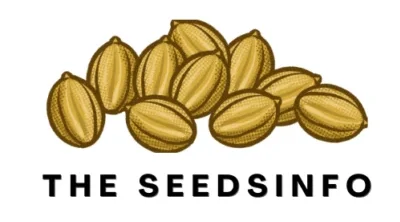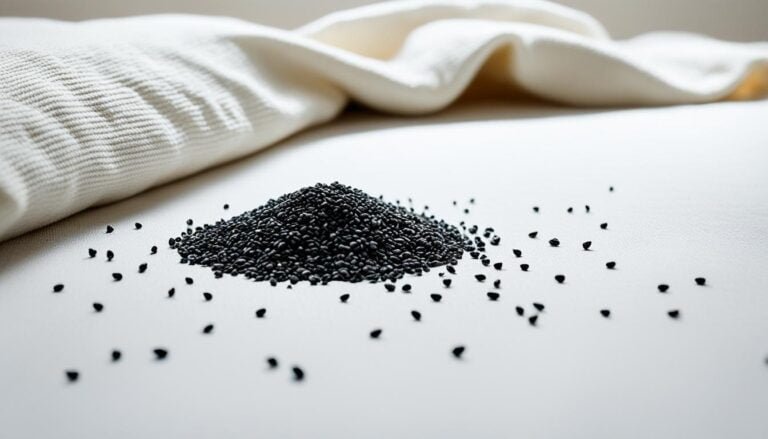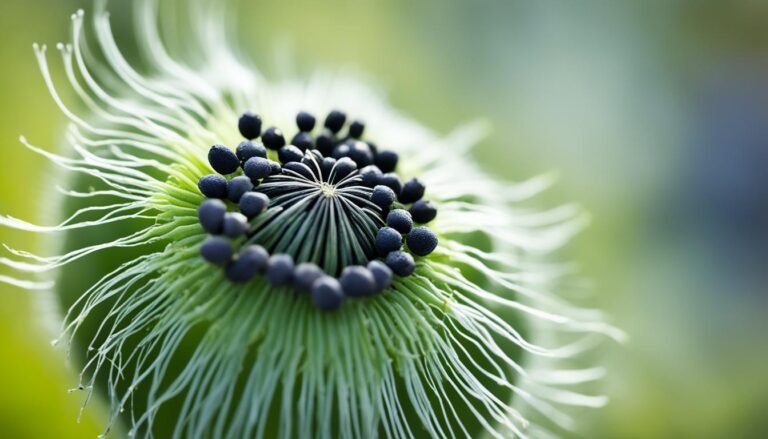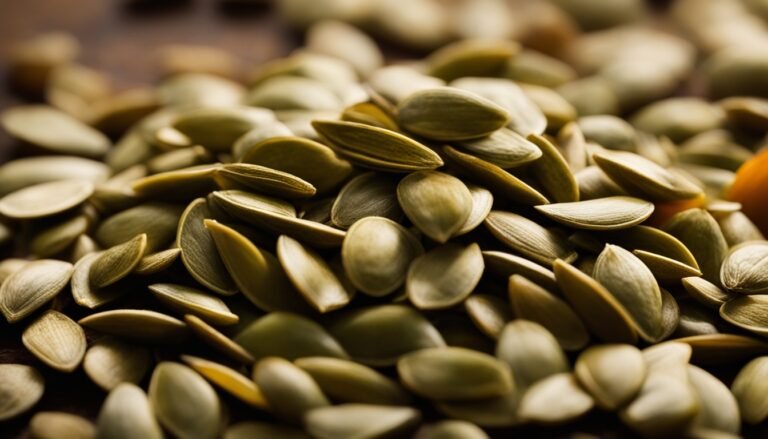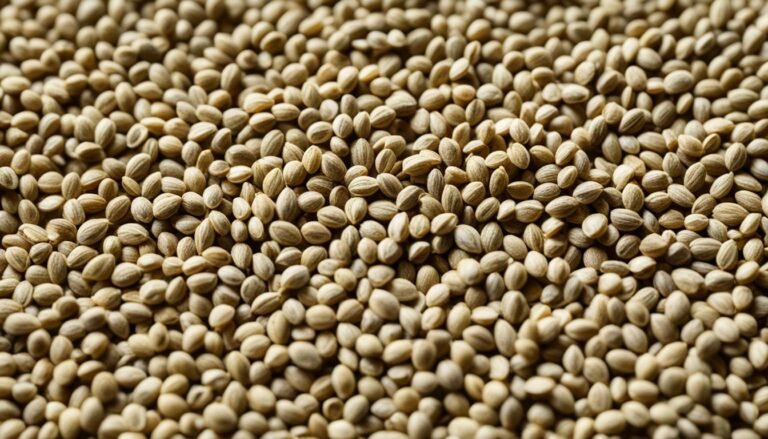Banana Seeds: The Truth About Growing Bananas

Did you know most bananas you buy at stores are seedless, like the Cavendish variety? They’re made from plants with three sets of genes, not two. This change makes sure the bananas we love do not have seeds.
The Cavendish banana is named after the 7th Duke of Devonshire, William Cavendish. He got a plant from Mauritius and grew it in England. Since 1836, these bananas and many others are not really trees. They are grown from underground stems, not seeds.
Key Takeaways
- Most store-bought bananas, like the Cavendish, are seedless and genetically modified to be triploid.
- The Cavendish banana was named after the 7th Duke of Devonshire, who cultivated it in England in 1836.
- Commercial bananas are grown as herbs, not trees, and are propagated using rhizomes rather than seeds.
- Wild banana varieties can contain significant seeds, which can make the fruit difficult to eat.
- While it is possible to grow bananas from seeds, they more commonly grow from bulbs or rhizomes in tropical regions.
What Are Banana Seeds?
If you take a wild banana and crack it open in the wild, you might find seeds. Some have seeds so big, they take up a lot of the fruit. It would be hard to just eat the fruit part. Still, you can buy and plant some wild banana types. Two good ones to try growing from seed are Musa acuminata and Musa balbisiana. They’re the starting point for some of the bananas we eat today.
Musa acuminata is more like the Cavendish banana you see in stores. But it’s usually grown for looks, not to eat. Then we have Musa balbisiana, the real wild banana. Some folks think its taste beats the bananas we get from stores.
Exploring the Hidden Gems Inside Wild Bananas
Most bananas we eat are made to not have seeds. But, the wild ones do. Their seeds can grow into new plants, but it takes time. Wild banana seeds need warm soil, around 68 degrees Fahrenheit, to start well. Buying these seeds can cost from $2.95 to $24.95, depending on the type.
| Banana Cultivar | Fruit Characteristics |
|---|---|
| AW24 Thailand Black Stem | Sweet fruits with seeds |
| JB137 Edible Banana | Sweet fruits with seeds |
| SF174 Royal Sweet Banana | Sweet fruits with seeds |
| 2050 Thomson’s Edible Banana | Sweet fruits with seeds |
| Dwarf Chinese Banana (Musa acuminata dwarf) | Smaller fruits with seeds, often grown for ornamental reasons |
| Blood Banana (Musa zebrina) | Grown for commercial fruit production and as an ornamental plant |
| Velvet Banana (Musa velutina) | Grown for commercial fruit production and as an ornamental plant |
Even though most bananas we eat are from South America, there are over 1,000 kinds in the world. They’re grouped into 50 categories. The type we often see, the Cavendish, doesn’t have seeds. But for those drawn to growing bananas from banana seeds, looking at wild bananas can lead to interesting discoveries.
Can You Grow Bananas from Seed?
Even though bananas usually come from small bulbs or rhizomes, you can try growing them from seeds. It’s not easy but can be rewarding with the right care. These seeds are rare finds in wild bananas. Getting them to sprout and grow can be a bit tricky.
If you want to try, start by soaking the seeds in water for a day. Then, plant them in a mix of sandy, loamy soil that drains well. Keeping the soil moist and the air warm, between 60 and 81 degrees F, is key for them to start growing.
The part where the banana plant flowers, known as the “banana inflorescence,” happens about 10-15 months after planting. You’ll see a good number of leaves, 26 to 32, by then. A flowering stalk will push through them from the middle of the plant’s stem.
But know, it’s tough to see edible fruits from plants you’ve grown from seeds. The Musa basjoo from Japan, for instance, offers great-looking leaves, not tasty bananas. Also, popular bananas in Europe and the US, like the Cavendish, are usually not grown from seeds.
| Statistic | Value |
|---|---|
| Musa basjoo growth rate | 6ft monsters of jungly foliage in just a few months |
| Musa basjoo cold tolerance | Survives temperatures down to -15°C |
| Cost of bananas grown from seed | A fraction of the price of buying ready-grown small plants |
| Edible fruit production | Musa basjoo won’t produce edible fruit |
| Seed preparation | Soak the hard, black seeds for 24 hours before sowing |
| Average banana consumption in the US | More than 75 bananas annually |
Growing bananas from seed is more for fun and learning than for a big harvest. It teaches you plenty about plants. You’ll know if it fits your gardening hopes and the weather of where you live.
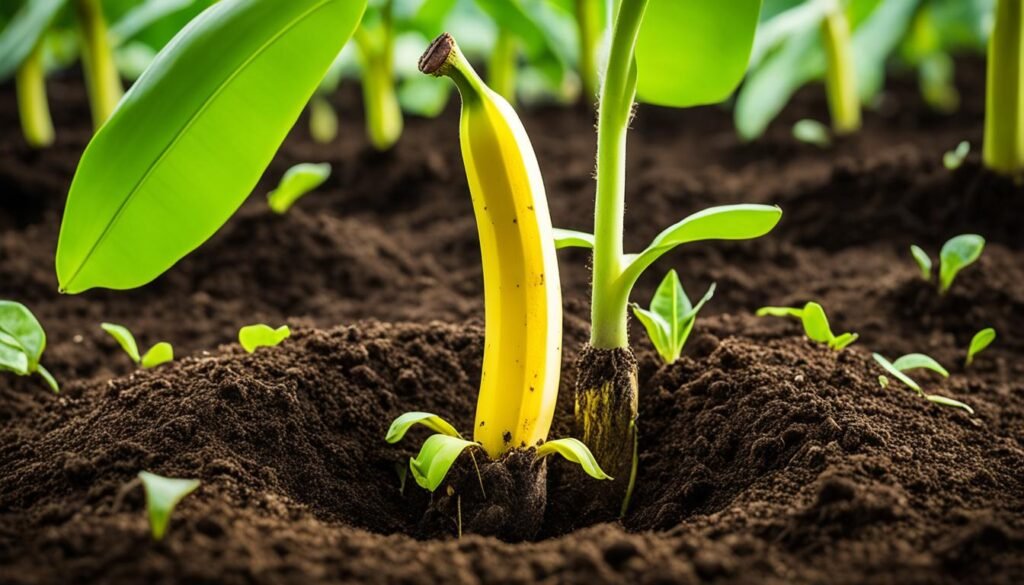
banana seeds Propagation and Cultivation
Step-by-Step Guide to Growing Bananas from Seed
Do you want to grow bananas from seed? It’s a rewarding journey with a few important steps. First, soak the seeds in warm water for 48 hours. Change the water as it cools. This will help the seeds to sprout.
Next, get your soil ready. Use a mix of potting soil with organic compost. It should be sandy and light. Plant your seeds 1/4 inch deep. Keep the soil moist, but not too wet. Use a heat mat to keep the soil warm.
The seeds will sprout at different times, but it can be quick or take a few months. Just watch and keep the soil warm and moist.
After the seedlings get their first leaves, move them to bigger pots or the garden. If you care for them well, you’ll enjoy your homegrown bananas.
| Banana Seed Propagation Techniques | Multiplication Rate | Advantages |
|---|---|---|
| Tissue Culture | 2-10 or more shoots per month | Rapid propagation, disease-free plantlets |
| Minisetting | Thousands of plantlets | Quick, inexpensive, high yield |
| Scalp Techniques | Highly effective | Clonal plants, commercial cost-effectiveness |
Follow these steps and use modern techniques to grow bananas from seed. You’ll add unique flavors and diversity to your garden.
Flavors and Varieties of Wild Bananas
Explore the exciting world of wild banana varieties. The usual Cavendish banana might be what we know, but wild seeds grow a wide range of tastes. Look closer at the world of wild banana varieties and find a new spectrum of banana flavor profiles.
Wild bananas from banana seed cultivars are often rich and sweet. They offer a bit more than our typical bananas. Species like Musa acuminata and Musa balbisiana stand out. They are the parents of many day-to-day bananas we see. Musa acuminata looks like the Cavendish but is less common to eat. On the other hand, some find Musa balbisiana tastier than what’s in stores.
“The flavor of wild bananas can be a revelation, with a depth and complexity that often surpasses the ubiquitous Cavendish.”
Looking at the wild banana varieties closely shows a big flavor range. Some have a cream-like texture, while others are more tart or even a bit savory. It’s like a treasure hunt for distinct banana flavor profiles.
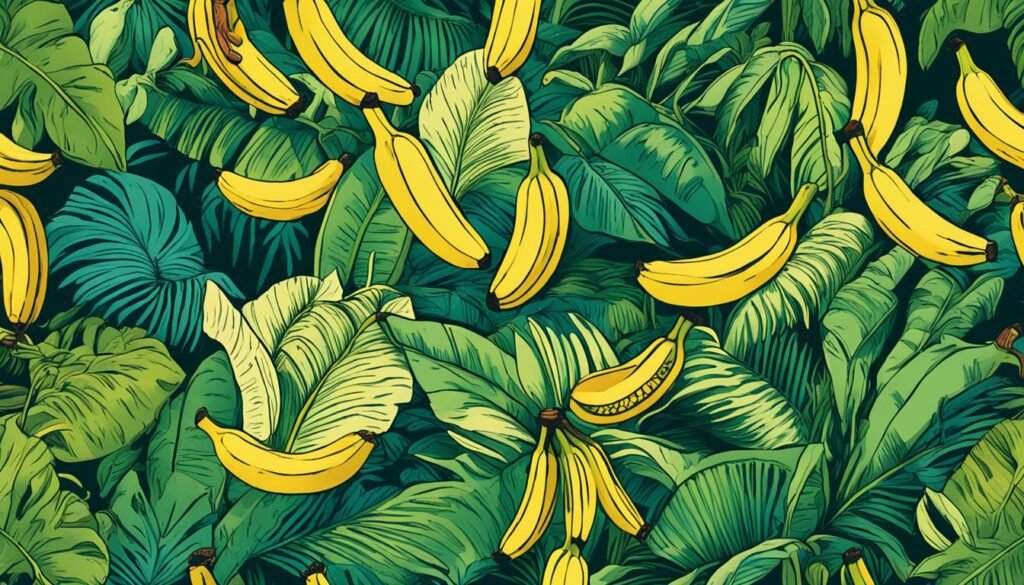
If you love bananas or are just starting to, try the wild and exotic kinds. Discover the world of banana seed cultivars. Enjoy the many flavors and textures. Let the wild bananas surprise and delight your taste buds.
The History of Seedless Bananas
The story of seedless bananas goes back more than a thousand years. They started to develop without seeds around 650 AD in Africa. The seedless Gros Michel banana became the top choice for many years. But around the 1950s, the Cavendish banana took over the market.
This new banana was named after William Cavendish, the 7th Duke of Devonshire. It entered the world stage in 1836. It was introduced to England after a friend of Cavendish’s sent a sample from Mauritius. This new variety spread to its native warm areas.
Today, the Cavendish type is the most popular in the banana market. But having just one main type has its problems. The Cavendish bananas are at risk from bugs and diseases. They are all genetically the same, which makes them more vulnerable.
“A typical Cavendish banana plantation is now spraying pesticides 25-50 times a year to fend off nature’s would-be consumers of this crop.”
Still, the journey of seedless bananas is full of fascinating moments. It shows how smart and resilient humans can be. We keep working to protect and grow this important fruit.
The Origins of Seedless Bananas
Humans are really the ones behind seedless bananas. These bananas, called parthenocarpic, first started as wild plants. They were hard to eat and didn’t have seeds. Then, about 7,000 years ago, people began making them better. They started selecting and growing the plants. This led to the first seedless bananas, with three sets of chromosomes.
We have evidence that people in Papua New Guinea were eating bananas over 10,000 years ago. Bananas were first made better in the Philippines and Papua New Guinea areas. These improved bananas then moved to Africa about 5,000 years ago.
In the late fourteenth and fifteenth centuries, European powers took a new interest in bananas. The Gros Michel variety became the top choice for over a hundred years. But it faced a deadly fungus, almost disappearing. This situation opened the way for the Cavendish banana to become the new favorite worldwide.
Now, keeping a good banana supply is a big challenge. The history of seedless bananas shows how clever and adaptable bananas are. This fruit has survived and thrived through ages of change and challenge.
The Banana Flowering Process
From Seed to Fruit: Understanding the Banana Life Cycle
From seed to fruit, the banana’s journey is truly captivating. This journey uncovers the detailed life cycle of the tropical plant. The heart of this process is the banana flowering, also known as “shooting.”
After 10 to 15 months from planting the seed, a banana inflorescence emerges. This is the flowering stalk, surrounded by 26 to 32 leaves. These leaves provide a protective layer for the flower.
The banana plant’s flowers appear in spirals. They come out in groups of 10 to 20. At first, you can see fleshy, purplish-to-greenish bracts. Then, these bracts fall away to show the first flowers. These flowers start as female. For edible bananas, the fast-growing ovaries turn into fruit without needing pollination.
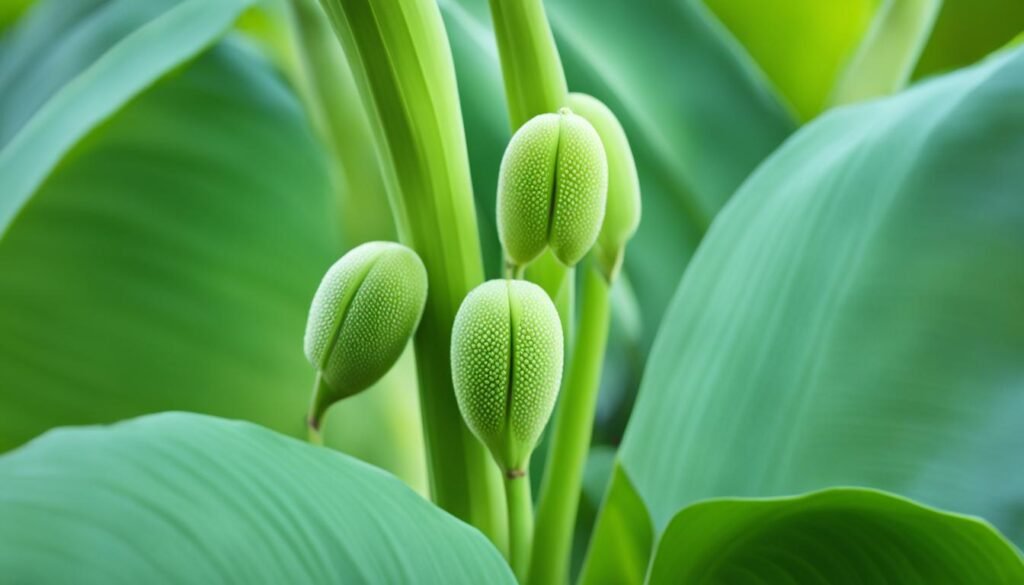
The banana plant does more than just flower and fruit. It also produces suckers, or new shoots, for growth. These suckers come from the base of the plant. They help the banana patch keep growing.
If you’re into growing bananas, knowing about their flowering process and life cycle is key. This knowledge is important for both cooking and beautifying gardens. It helps us see how the banana, a worldwide favorite, is so strong and adaptable. It continues to be a top choice for many around the globe.
Challenges of Growing Bananas from Seed
Growing bananas from seed is a mix of joy and hard work. It’s different from the usual way of using rhizomes or suckers. You face several hurdles from start to seeing your first fruit.
The first big challenge is the time it takes to start. Banana seeds take 3 weeks to 6 months to begin growing. This is much longer than the 180 days needed for rhizomes. You need to be patient and keep looking after them to make them grow well.
Then, there’s the wait for them to bear fruit. With seeds, it might take 14 months or even longer. This is a big difference from 180 days with rhizomes. It can be hard for some to wait that long to see results.
- Banana seeds can take 3 weeks to 6 months to germinate, much longer than rhizome propagation.
- Banana plants grown from seed may not fruit for 14 months or more, compared to 180 days for rhizome propagation.
- Precise tropical conditions are required for successful banana seed germination and cultivation.
Also, getting the right tropical conditions for banana seeds is tricky. You have to watch the temperature, humidity, and soil moisture very closely. This just adds more to the work of growing them.
| Characteristic | Banana Seed Propagation | Rhizome Propagation |
|---|---|---|
| Germination Time | 3 weeks to 6 months | Immediate |
| Time to Fruit | 14 months or more | 180 days |
| Tropical Conditions Required | Precise | Moderate |
But, even with these tough parts, growing from seed can be really rewarding. You learn a lot and get a true sense of accomplishment. With the right knowledge, growers can beat these challenges and grow beautiful banana plants.
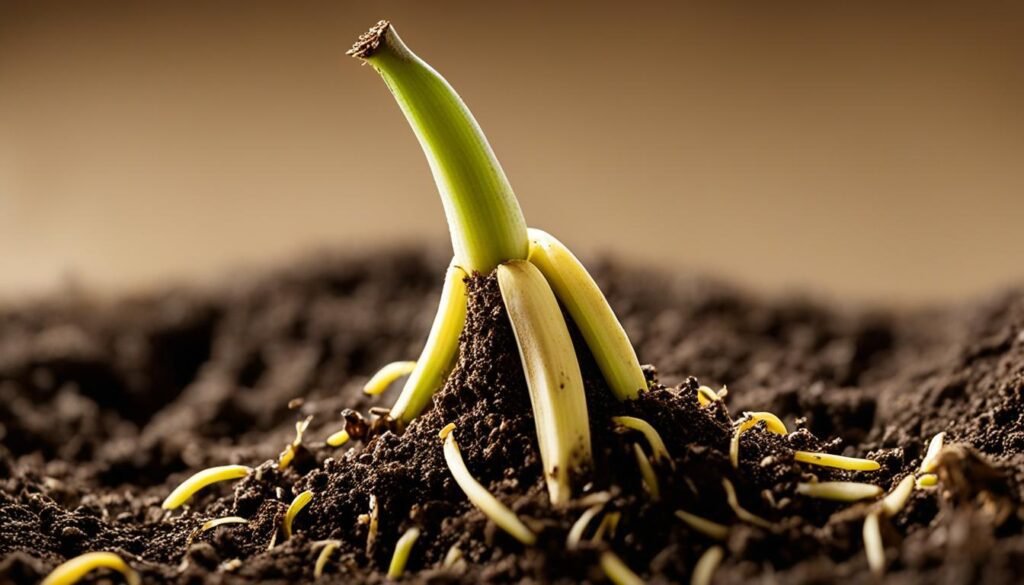
Sourcing Wild Banana Seeds
If you want to grow bananas from seed, finding trusty wild banana seeds is critical. Most bananas in stores don’t have seeds. But, you can still locate the tiny, hard, black seeds inside wild banana types that are less than half an inch wide.
Buying from online stores dedicated to banana seeds is a smart move. A seller named “musa777” stands out for providing fresh wild banana seeds. This is a great first step for finding banana seeds.
When you find a seed, peel the banana and take the fruit away. You’ll see the hard, black, small seed inside, around 1/2 inch wide. That’s how wild banana seeds look.
| Banana Seed Supplier | Seed Varieties | Pricing |
|---|---|---|
| musa777 | Wild Banana Species | $3.95 for 5 seeds, $12.95 for 25 seeds |
| SF174 Royal Sweet Banana | Royal Sweet Banana | $3.95 for 5 seeds, $12.95 for 25 seeds |
Remember, finding wild banana seeds requires some effort. Yet, with a bit of digging and a never-give-up attitude, you can locate trustworthy where to buy banana seeds, banana seed suppliers, and banana seed sources. This is the start of your banana-growing journey.
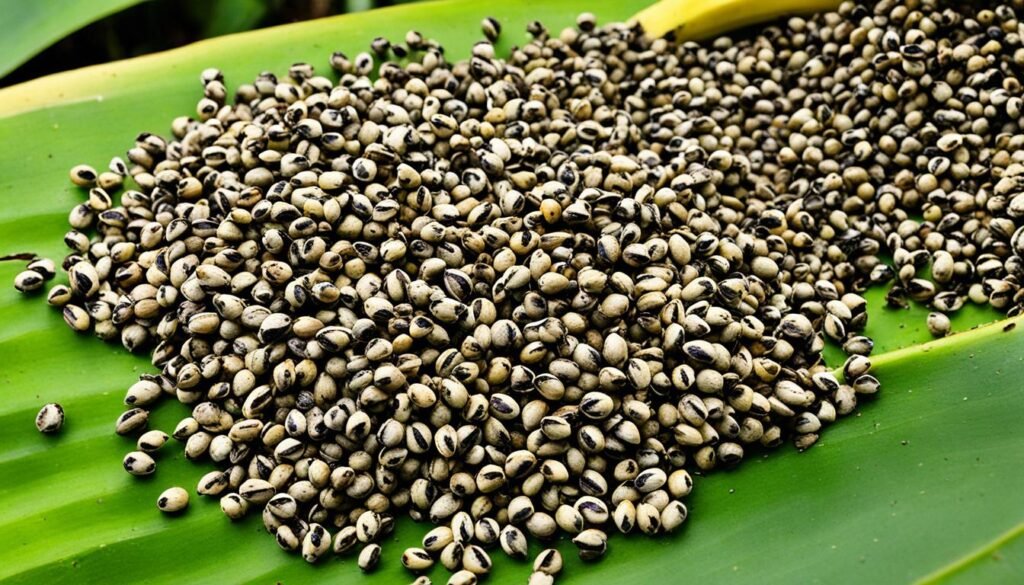
Ornamental and Decorative Banana Varieties
Looking to add a tropical feel to your garden? Ornamental and decorative banana plants are a great choice. They bring lush greenery with a splash of vibrant colors, various shapes, and sizes, perfect for any garden.
Bringing Tropical Flair to Your Garden
The Basjoo (Musa ‘Basjoo’) is a top pick, reaching 12-15 feet in height. It can grow in very cold areas, down to USDA zone 4. The Bordelon (Musa ‘Bordelon’) is similar in size but can handle a bit less cold, down to zone 8.
The Golden Lotus (Musella lasiocarpa) is a smaller option, growing 5-6 feet tall and suited for zone 7. If space is limited, the Musa Dwarf Cavendish Banana Tree is perfect; it grows to 4-6 feet tall. This makes it ideal for indoor or small outdoor gardens.
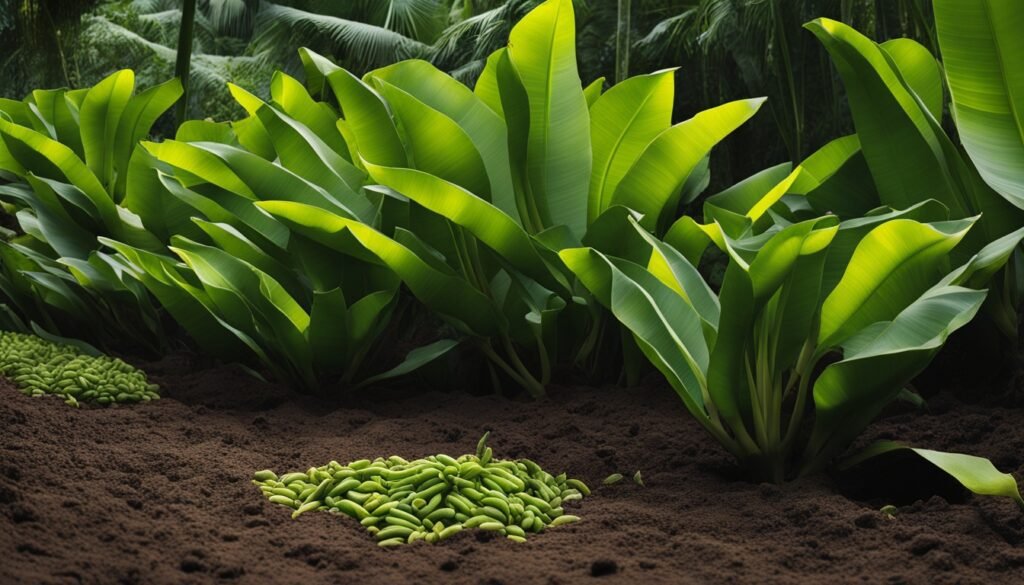
Taking care of these plants means regular, deep watering, about 1-2 inches each week. They need soil that drains well but stays consistently damp. Fertilize with a slow-release product high in potassium 2-3 times yearly.
Keeping your ornamental banana plants healthy is simple. Every 2-3 years, cut and replant the suckers. This prevents overcrowding and aids in their continued growth.
| Variety | Height | Hardiness Zone |
|---|---|---|
| Basjoo (Musa ‘Basjoo’) | 12-15 feet | USDA Zone 4 |
| Bordelon (Musa ‘Bordelon’) | 12-15 feet | USDA Zone 8 |
| Golden Lotus (Musella lasiocarpa) | 5-6 feet | USDA Zone 7 |
| Musa Dwarf Cavendish Banana Tree | 4-6 feet | Suitable for containers |
Adding these banana plants to your space can turn it into a tropical paradise. From outdoor gardens to indoor settings, there’s a perfect match for everyone. Discover your favorite from the diverse collection available.
Conclusion
In summary, you usually find seedless bananas at the grocery store. But, you can grow special wild banana kinds from seed. These bananas won’t be like the common Cavendish kind. They will have seeds and taste very different.
To grow bananas from seed, you need the right warm and humid environment. It takes time and care, but it’s fulfilling. You might do it for their beauty or their different taste. Either way, it’s an interesting way to dive into the world of bananas.
There are many things to know when growing bananas from seed. Conservation and getting the seeds to sprout can be tricky. Wild banana types are also quite unique. Learning about their growth cycle is vital. By starting from scratch, you learn a lot and help keep these plants diverse.
FAQ
What are the “seeds” I see in bananas from the grocery store?
The small brown spots you notice in bananas at the store aren’t real seeds. They’re tiny, underdeveloped parts that cannot grow into plants. Bananas, like the common Cavendish type, are specially developed to not have seeds.
Can you grow bananas from seed?
True, you can get bananas from the seeds of a few wild types. Yet, the bananas that grow will not be the common ones you are used to. This process needs a lot of care and must have the perfect warm environment found in the tropics.
How do I grow bananas from seed?
Start by soaking the seeds. Then plant them in mix of sand and loam. Keep the soil moist and at warm temperatures. It will usually take between a few weeks to several months for the seeds to start growing, and over a year for bananas to appear.
What are some good banana seed varieties to try growing?
For those who want to give it a go, Musa acuminata and Musa balbisiana are good choices. Musa acuminata is a bit like the Cavendish but with seeds, and Musa balbisiana is a far more wild type.
How do wild bananas grown from seed differ in flavor?
Bananas that come from seeds often taste creamier and sweeter. They have a bit of the usual banana flavor too. Surprisingly, some even like wild banana flavor better than the Cavendish.
Where can I find banana seeds to purchase?
For those looking to buy, specialized seed stores are a good start. For example, check out musa777 online. They sell fresh, wild banana seeds ready for planting.
Are there any ornamental or decorative banana varieties I can grow?
Definitely, smaller kinds like Musa dasycarpa, Musa ornata, and Musella lasiocarpa are perfect for pots. They’re beautiful with gorgeous flowers, making them great for decoration.
